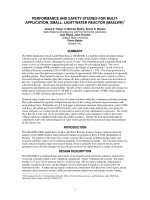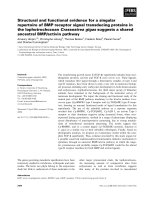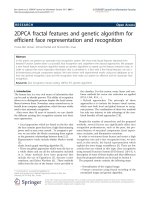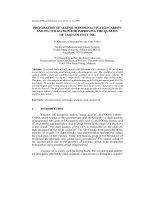GIS and ant algorithm for multi objective siting of emergency facilities
Bạn đang xem bản rút gọn của tài liệu. Xem và tải ngay bản đầy đủ của tài liệu tại đây (1.6 MB, 99 trang )
GIS AND ANT ALGORITHM FOR MULTI-OBJECTIVE
SITING OF EMERGENCY FACILITIES
LIU NAN
NATIONAL UNIVERSITY OF SINGAPORE
2004
GIS AND ANT ALGORITHM FOR MULTI-OBJECTIVE
SITING OF EMERGENCY FACILITIES
LIU NAN
(B. Eng., Tsinghua University)
A THESIS SUBMITTED
FOR THE DEGREE OF MASTER OF ENGINEERING
DEPARTMENT OF CIVIL ENGINEERING
NATIONAL UNIVERSITY OF SINGAPORE
2004
Acknowledgements
ACKNOWLEDGEMENTS
The author wishes to express his deepest appreciation to both of his supervisors,
Assistant Professor Huang Bo and Assistant Professor Lee Der-Horng, for their
rigorous scientific guidance, invaluable constant advice, constructive suggestion, and
continuous support throughout the course of his master study in NUS, and their care
and advice on his personal matters as well.
The author would also like to thank Associate Professor Cheu Ruey Long and
Assistant Professor Meng Qiang for their kindly help and encourage through my whole
study in NUS. Especially, the author would like to express his sincere gratitude to
Professor David E. Boyce for his guidance and suggestions on both my academic
research and personal life.
The author is pleased to thank Mr. Foo Chee Kiong, Mr. Ooh Sing Hua, and all other
technicians & administrative staffs for their friendship and kind assistance.
Particularly, the author would like to thank his colleagues in the ITVS Lab, Sun
Yueping, Pan Xiaohong, Yao Li, Huang Wei, Fan Tao, Song Liying, Zheng Weizhong,
Xie Chenglin, Cao Zhi, Deng Weijia, Fery Pierre Geoffroy Julien, Alvina Kek Geok
Hoon and Huang Yongxi. The author also wishes to thank his undergraduate
classmates in Tsinghua University, Mu Dapeng, Gu Weihua, Li Xiaodong, Yan Feng,
I
Acknowledgements
Shen Wei and Chen Lichun. Besides, the author would like to thank his alumni of the
high school, Shi Guangkai, Zhang Ting, Zheng Yu, Chen Yuzhen, Ke Xuqing, Miao
Ran, Wu Linfeng and Liu Rongbin. The author is highly appreciated to the
encouragement and help from his peers in these two years. A special note of
thankfulness is also expressed to others who have helped him in one way or other.
Special thanks are due to the National University of Singapore for providing the author
with a research scholarship covering the entire period of his graduate studies.
Last but not the least, the author would like to take this opportunity to express his
deep-hearted gratitude to his parents, aunts, uncles, and all relatives for their
understanding, concern, and support all the time.
II
Table of Contents
TABLE OF CONTENTS
I
Acknowledgements
Table of Contents
III
Summary
VI
List of Tables
List of Figures
Chapter 1
VIII
IX
Introduction
1.1 Background
1
1.2 Research Scope and Purpose
4
1.3 Organization of the Thesis
5
Chapter 2
Literature Review
2.1 Geographical Information System
7
2.1.1 General Introduction to GIS
8
2.1.2 ArcGIS Software
2.2 Geographical Information System and Location Science
10
10
2.2.1 General Review
11
2.2.2 Bridging between GIS and Facility Location
13
2.3 Emergency Facility Location
2.3.1 Emergency Facility Location Models
16
16
III
Table of Contents
2.3.2 Optimal Siting of Fire Stations and HAZMAT Routing
2.4 Ant Algorithms
19
22
2.4.1 Introduction to Ant Algorithms
22
2.4.2 Ant Algorithm Family
27
Chapter 3
A Generic GIS-supported Multi-objective Optimization Model
3.1 Multi-objective Optimization
29
3.1.1 General Introduction to MO Optimization
29
3.1.2 Scalarization Methods
30
3.2 GIS Analysis
33
3.2.1 Data Models in GIS
33
3.2.2 Spatial Analysis in GIS
35
3.3 A Generic GIS-supported MO Optimization Model
37
3.3.1 Development of a Generic MO Optimization Model
37
3.3.2 Model Implementation in a Raster GIS Environment
40
3.4 Summary
Chapter 4
44
An Ant Algorithm for Multi-objective Siting of Emergency
Facilities
4.1 Overview of the Ant Algorithm
45
4.2 Pheromone Matrix and the Updating Rules
46
4.3 Solution Construction
49
IV
Table of Contents
4.4 Two-phase Local Search
50
4.5 Evaporation
52
4.6 Diversion Mechanism
52
4.7 Summary
53
Chapter 5
Multi-objective Siting of the Proposed New Fire Stations in
Singapore
5.1 Background Information
54
5.2 Problem Analysis
57
5.3 Methodology
58
5.3.1 Construction of the Two-level Grids
59
5.3.2 Calibration of the Response Time Function
60
5.3.3 Implementation of the Generic MO Optimization Model
63
5.3.4 Model Analysis
65
5.4 Computational Results and Analysis
66
5.5 Summary
74
Chapter 6
Conclusions and Recommendations
6.1 Conclusions
76
6.2 Recommendations for Further Research
78
References
80
V
Summary
SUMMARY
Efficient and timely response during accidents has always been a heated area for
researchers and practitioners. Emergency facilities, e.g. hospitals, fire stations, police
stations, etc., are equipped with necessary personnel and paraphernalia for saving life
and property in the event of an accident. The location of emergency facilities plays a
crucial role in determining the efficiency of safety protection and emergency response.
Since 1970s, GIS (Geographical Information System) has been viewed and employed
as a powerful spatial analysis tool in location research. A number of researchers and
practitioners have devoted their efforts to studying the method of applying GIS in
siting analysis and utilizing it to solve location problems (with multiple objectives).
However, as the fields of OR (Operations Research), location science and geographical
information science are developing at a tremendous speed, there exists a large
exploration space addressing the methodology of integrating GIS with state-of-the-art
OR techniques to solve location problems. This thesis, exactly, is focused on the study
of this kind of methodology with a specified emphasis on emergency facility siting
problems.
This research introduces a generic MO (Multi-Objective) optimization model for
emergency facility siting problems in the GIS environment. Without loss of generality,
the model is formulated using the λ transformation, which maximizes the minimal
achievement level of all objectives considered. A relevant local search heuristics, the
Ant Algorithm, has been developed to solve the problem, especially of a large scale, on
a raster data structure. The algorithm is loosely coupled with the GIS environment.
VI
Summary
A hypothetical case study of the optimal siting of six additional fire stations in
Singapore has been carried out to test the performance of the methodology developed
in this research. The difficulties of this case problem lie in that: (i) the solution space
of the problem is a polygon of irregular shapes which can hardly be accurately
confined; (ii) one objective of the problem is to maximize the coverage on linear
features which has rarely been addressed in literatures. However, GIS provides a handy
way to tackle these two difficulties, and has been used for data conversion, calibration
and representation. A relevant MO optimization model has been developed to this
problem and the Ant Algorithm (ANT) has then been implemented to solve it. In
comparison with an existent GA (Genetic Algorithm) which is the only heuristics
available for solving a similar problem, ANT outperforms GA in terms of both
computational accuracy and stability. The ANT itself has also been thoroughly
analyzed through a series of computational experiments, which lead to four findings: (i)
the pheromone information contained in the pheromone matrix does help artificial ants
find better solutions; (ii) the local search measure proposed in the Ant Algorithm is a
better solution method than population-based search heuristics in solving this type of
location problems; (iii) the first phase local search, which involves randomness and is
typically handled by the ant part, is critical in improving the efficiency of Ant
Algorithm; (iv) the diversion mechanism, an optional component of the Ant Algorithm,
may not provide it with an edge in solving this kind of large scale location problems.
Keywords:
GIS;
Heuristics;
Ant
Algorithm;
Multi-Objective
Optimization;
Emergency Facility Siting.
VII
List of Tables
LIST OF TABLES
Table 2.1 Ant Algorithm Family
28
Table 5.1 Computational Results of GA, RANDOM and ANTs
69
Table 5.2 Computational Results of ANTs with Different Diversion Steps
72
Table 5.3 The Best Objective Achievement Levels
73
VIII
List of Figures
LIST OF FIGURES
Figure 2.1 The Schematic Structure of Ant Algorithms
24
Figure 2.2 Decision-making Process of an Artificial Ant
25
Figure 3.1 Vector Data Model vs. Raster Data Model
34
Figure 3.2 Steps of Doing GIS Analysis
36
Figure 3.3 Linear Membership Function
38
Figure 3.4 A Linear Feature and its Raster Representation
41
Figure 3.5 Data Bridge in the Loosely Coupled Approach
44
Figure 4.1 The Flowchart of the Ant Algorithm
46
Figure 5.1 Existing Fire Stations and the SCDF Routes in Singapore
55
Figure 5.2 The Macro and Micro Grids
60
Figure 5.3 Uncovered SCDF Routes by Existing Fire Stations within 5 minutes
62
Figure 5.4 Uncovered Areas by Existing Fire Stations within 6 minutes
62
Figure 5.5 The 2nd Objective Achievement Level of an Individual Fire Station
65
Figure 5.6 Locations of the Six New Proposed Fire Stations
74
IX
Introduction
CHAPTER 1
INTRODUCTION
1.1 Background
Efficient and timely response during accidents has always been a heated area for
researchers and practitioners. More so in the wake of the September 11 terrorist attacks,
following which security and emergency response issues have received greater
attention. Emergency facilities, e.g. hospitals, fire stations, police stations, etc., are
equipped with necessary personnel and paraphernalia for providing prerequisite
support and saving life and property in the event of an accident. The location of
emergency facilities plays a crucial role in determining the efficiency of safety
protection and emergency response. Emergency facilities should be sited in such a
strategic way that they can serve as many areas as possible in a reasonable time during
daily operations and have an efficient cooperation among them in time of necessity.
Typical questions arising in emergency facility siting are like follows: how many
hospitals are needed in a particular region, and where should they be sited to assure
reliable service to medical emergencies; where should fire stations be located in a
certain city so that fire trucks can make an timely response to fire accident sites to
minimize damages and save lives; how many and where should police stations be set
1
Introduction
up in a specific urban area in order to reduce the risk of crime. These questions, as well
as the design and configuration of emergency response system, have been thoroughly
studied by a number of researchers over the last 30 years using traditional OR
(operation research) methods, e.g. integer linear programming techniques. They
established various types of mathematical models, e.g. LSCP (Location Set Covering
Problem, Toregas and ReVelle, 1973; Toregas et al., 1971), MCLP (Maximal Covering
Location Problem, Church and ReVelle, 1974), FLEET (Facility Location, Equipment
Emplacement Technique, Schilling et al., 1979), and at the same time developed
relative heuristic algorithms for solving them.
With the development of geographical information science, geographical information
systems (GIS) have gradually evolved into a mature research area and been involved
into the field of location science since 1970s. GIS provides a platform for spatial data
collection, retrieval and storage, and supports many elementary and advanced spatial
analytical functions for location studies. Not only can GIS be used for model
development and implementation, it is also able to serve as a visualization tool which
can present model results and produce high quality maps for different purposes.
Moreover, GIS offers a strong function to integrate data from various sources and
convert them into a same coordinate system for utilization.
One of the most important functions of GIS is its ability to store the information of
various types in separate data layers, whereby researchers can take advantage of these
2
Introduction
layers to do siting analysis by the sheet-superimposing method (McHarg, 1969). To do
that, researchers may first determine the weight with regard to each criterion that is
represented by a certain individual layer, assign the weights to the data layers
correspondingly, and then combine all the data layers weightedly into one layer to
identify the most suitable sites.
The other important, yet useful function of GIS is that almost all of the current GIS
software provides a friendly programming environment to users to customize their
own applications, e.g. ArcGIS provides a VBA (Visual Basic for Application)
environment where users can easily code their own programs in VB (Visual Basic) and
with the ArcObjects, the development platform of ArcGIS family of applications.
Another strength of the programming environment in GIS lies in that it can recognize
and utilize the functions coded in other computer languages, e.g. C, C++, etc., through
the use of DLL (Dynamic Link Library) techniques, which greatly improves the
interoperability between GIS and other programming software, e.g. Microsoft Visual
Studio.
In respect that GIS bears many merits that are very useful to location science, a lot of
researchers have tried to incorporate and utilize GIS in their studies on either siting
analysis or other location problems (Dobson, 1979; Pereira and Duckstein, 1993;
Carver, 1991; Murray, 2003; etc.). However, as OR (Operations Research), location
science and geographical information science are developing at a tremendous speed,
there exists a large exploration space addressing the methodology of integrating GIS
3
Introduction
with state-of-the-art OR techniques to solve location problems. This thesis, exactly, is
focused on the study of this kind of methodology with a specified emphasis on
emergency facility siting problems.
1.2 Research Scope and Purpose
As in solving any other traditional optimization problems, there is a two-step
procedure in solving an emergency facility siting problem, which is, step 1: set up a
proper optimization model and identify the relevant constraints; and step 2: develop an
appropriate solution algorithm and implement it to get results. However, in some cases
it is not that easy to establish a proper model for the problem and prepare the input
data for the model, and therefore, certain pretreatments on the initial data need to be
carried out. GIS provides a suite of powerful spatial data manipulation and analysis
functions and may help in these pretreatments. On the other hand, some data for the
model may only be stored in a GIS, or can be retrieved from there very easily. Besides,
GIS is also a good platform for data organization, model implementation as well as
result visualization, and can be further employed to develop some more advanced
decision-making systems.
In view of the powerful functions that GIS can offer to solve siting problems, this
research is to implement a proposed generic MO (Multi-Objective) model for
4
Introduction
emergency facility siting problems in a GIS environment, and show what the GIS
environment can bestow on the model. In tackling practical problems, the model may
be established on a raster data structure, and thus is a “discrete” one and tends to be
intractable if the problem size goes large. To treat this type of difficult problems, the
research proposes a relevant meta-heuristic algorithm, namely Ant Algorithm, which is
an agent-based local search heuristics, to solve the large scale emergency facility siting
problems in a raster GIS environment. The efficiency of the whole proposed
methodology is also to be evaluated through a case study and a series of computational
experiments.
1.3 Organization of the Thesis
There are totally six chapters in this thesis, including this introductory chapter. Chapter
2 is the literature review chapter, which consists of three major sections: (i)
Geographical Information Science and Facility Location; (ii) Emergency Facility
Location; and (iii) Ant Algorithms.
Chapter 3 presents the generic MO optimization model for emergency facility siting
problems in a GIS environment. GIS and GIS software is first reviewed, which is
followed by an introduction to the GIS analysis method. The generic MO optimization
model in GIS is given at the end.
5
Introduction
Chapter 4 introduces the proposed Ant Algorithm for solving large scale emergency
facility location problems in a raster GIS environment. The overall procedure of Ant
Algorithm is provided at the beginning, and each component of the algorithm is
described subsequently.
Chapter 5 shows the implementation of the methodology given in this research to an
example problem, the optimal siting of proposed new fire stations in Singapore. The
whole procedure in solving the problem is discussed in detail and a series of
computational experiments and comparison are administered to test the performance of
the proposed methodology.
Chapter 6 concludes this thesis, and provides some recommendations for future
research.
6
Literature Review
CHAPTER 2
LITERATURE REVIEW
As discussed in Chapter 1, this thesis is focused on the study of integrating GIS with
state-of-the-art OR techniques to solve emergency facility siting problems. This
chapter deals with the review of related literatures. First, it reviews the geographical
information system and introduces related software. Then, the relationship between
geographical information systems and location sciences is discussed. This is followed
by a review of the emergency facility location models, where the optimal siting of fire
stations and HAZMAT (Hazardous Material) routing are highlighted. Ant Algorithms
are reviewed at the end of this chapter.
2.1 Geographical Information System
Since 1970s the field of GIS (Geographical Information System) has evolved into a
mature research and application area involving a number of academic fields including
Geography, Civil Engineering, Computer Science, Land Use Planning, and
Environmental Science (Church, 2002). GIS software provides many elementary and
advanced spatial analytical approaches which support studies in different areas. To be
noted, GIS plays a more and more significant role in location science, especially in
location model development and implementation, in a way that it supports a wide
range of spatial queries that can be of great use to location studies.
7
Literature Review
2.1.1 General Introduction to GIS
A GIS is a computer system designed to efficiently capture, store, update, manipulate,
analyze, and display all forms of geographically referenced information. Simply put, a
GIS combines layers of information about a place to give users a better understanding
of that place (GIS Website, 2004). A full GIS consist of hardware (computers and
peripherals), GIS software, data and operation personnel etc.
The power of a GIS over paper maps is its ability to help select the information users
need to see according to what goal users are trying to achieve. Unlike with a paper
map where “what you see is what you get”, a GIS can either combine or separate
layers of information according to users’ requirements and clarify the information to
different users. For example, a logistics planner trying to map customers in a particular
city will want to see very different information than a transportation engineer who
cares more about the road network for the same city. Generally speaking, the benefits
of using a GIS include (GIS Website, 2004):
z
Improve organizational integration
z
Make better decisions
z
Produce maps easily
GIS software provides the functions and tools needed to store, analyze, and display
information about places. GIS software ranges from low-end business-mapping
8
Literature Review
software appropriate for displaying sales territories to high-end software capable of
managing and studying large protected natural areas (GIS Website, 2004). The key
components of GIS software are:
z
Tools for entering and manipulating geographic information
z
A database management system (DBMS)
z
Spatial analysis tools that create intelligent digital maps users can analyze, query for
more information, or print for presentation
z
An easy-to-use graphical user interface (GUI)
There are a lot of available GIS software for both industries and academia. Some of the
popular ones are introduced here. For example, ArcGIS (developed by ESRI Ltd.,
Environmental Systems Research Institute) is a family of software for the desktop
(ArcView, ArcEditor and ArcInfo), but the software family also includes solutions for
developers (MapObjects), the enterprise (ArcSDE) and the Internet (ArcIMS).
GeoMedia is the core GIS platform developed by Intergraph Ltd. and it provides
extensions for various disciplines. MapInfo Professional developed by MapInfo Ltd. is
another piece of popular GIS software for the desktop; the software offers developer
components (MapX) and Internet solutions (MapXtreme). Autodesk Map (built on
AutoCAD), Envision (a desktop/Tablet product) and MapGuide (an Internet solution)
are the desktop GIS software developed by Autodesk Infrastructure Solutions
Divisions (GISMonitor Website, 2004).
9
Literature Review
2.1.2 ArcGIS Software
ArcGIS is one of the most popular desktop GIS and mapping software, which provides
data visualization, query, analysis, and integration capabilities along with the ability to
create and edit geographic data. This software has been used widely in many
universities and research institutes due to its multi-functionality and easiness to operate.
Furthermore, in its upgraded version, ArcGIS 8.x maintains the base functionality of
ArcGIS 3.x and adds a host of improvements driven by user requests. New features
include a catalog for browsing and managing data, on-the-fly coordinate and datum
projection, metadata creation, customization with built-in VBA, new editor tools,
support for static annotation, enhanced cartographic tools, direct access to Internet data,
and much more (ESRI Website, 2004). Since the research laboratory where the author
worked possesses the ArcGIS 8.2 software, it has then been utilized to be the platform
for data conversion, model implementation and solution evaluation. Nevertheless,
other GIS software may also satisfy the requirements and be used to achieve the goal.
2.2 Geographical Information System and Location Science
GIS has been viewed and employed as a powerful spatial analysis tool in location
research for more than thirty years. The application of GIS to location studies has
aroused a lot of interests in both academia and industries, and resulted in fruitful
10
Literature Review
achievements. Church (2002) did a thorough review on the existing work linking GIS
and location science, and asserted that GIS can support a wide range of spatial queries
that aid location studies. He also discussed some of the potential research areas relating
GIS and location modeling. As he concluded in his paper, GIS will have a major
impact on the field of location science in terms of model application and model
development.
2.2.1 General Review
Since 1970s, within the realm of Geographic Information Systems (GIS), location
problems have been studied extensively (Goodchild, 1992). Many researchers and
practitioners have devoted their efforts to studying the method of applying GIS in
siting analysis and utilizing it to solve location problems (with multiple objectives).
One of the best early example work in using GIS to do siting analysis was that of
Dobson (1979). He utilized a GIS to identify the possible locations for a power plant in
the State of Maryland. To this end, the state of Maryland was divided into
approximately 32,000 cells, each measuring around 2,000 feet × 2,000 feet.
Numerous attributes were taken into account in each cell including land use, land cover,
access to roads, soil, distance to transmission grid, population density etc. A weighted
suitability score was determined for each cell and then a map was produced to
represent those cells scoring in the top 15%. The weights applied for each criterion was
11
Literature Review
calculated by several nominal groups. Such a process mimics the sheet-superimposing
method proposed by McHarg (1969).
Another good example of suitability analysis can be found in Pereira and Duckstein
(1993), which dealt with habitat identification and protection. In their research, a GIS
was employed to create suitability maps by combining various data layers, which can
be used to screen out infeasible and undesirable sites, e.g. catchment areas or soils with
poor geotechnical characteristics.
GIS application in siting analysis and solving location problems demonstrated its
strength and efficiency, and has always been a heated research area since then. Carver
(1991) integrated a multi-criteria approach with GIS for suitability analysis. Marks et
al. (1992) dealt with the potential siting of hospitals to provide cost-effective health
care with a GIS. Estochen et al. (1998) used a GIS to determine the location/allocation
of emergency response vehicles in the state of Iowa. Through GIS, the response times
were estimated and compared to actual response times. Murray (2003) utilized GIS to
provide a scheme of assessing the efficiency of a siting configuration under
uncertainty.
On the other hand, facility location problems have been independently and intensively
researched over the past several decades. Traditional discrete and network location
problems, which include covering problems, center problems, median problems and
12
Literature Review
fixed charge facility location problems, were reviewed in detail by Mirchandani and
Francis (1990) and Daskin (1995). Common measures to cope with these problems are
to establish relevant integer linear programming (ILP) models, and then resolve these
models by either Branch-and-Bound (B&B) method, cutting-plane method or other
heuristic algorithms, e.g. Lagrangian relaxation heuristics. Brandeau and Chiu (1989)
conducted a comprehensive survey of more than 50 representative problems in the
location research, where they classified location models in terms of the number of
facilities being located. Since this thesis is focused on emergency facility location
problems, the review to this special type of location problems will be extracted and
given in the next sections.
2.2.2 Bridging between GIS and Facility Location
As addressed in Church (2002), GIS bears at least four merits which may be
significant aid in location modeling areas, and therefore, has a strong tie to location
sciences. Not only can GIS be a tool for collecting and storing data for location
modelers, it can also be used for data manipulation and analysis, e.g. data format
conversion. The data collected and stored in GIS for one purpose can be easily made
available for other applications, and thus the cost spent on data acquirement may be
greatly reduced. Furthermore, GIS is also a good presentation and evaluation platform
for the results of location models.
13
Literature Review
z
Data collection and storage
GIS is a computer system where the collected data can be stored and organized in
different data layers. For example, in a GIS database which stores the information of
the urban areas of a certain county, the data layers may include transportation network,
infrastructure network, e.g. electric line and water pipeline network, land use, soil
types, land covers, etc. It is further assumed that a retailing enterprise, which intends to
set up some new shopping outlets in this county, has mapped its existent outlets and
customers in this GIS database. The enterprise has certain constraints on building its
new outlets, one of which may be like that the new outlets should be within the
50-meter-buffer of transportation network so that they will have a good traffic access.
In this example, which is a very common case in real practice, GIS can be used to
easily identify the potentially feasible sites for the new outlets to be built as well as
generate data for a specific location model for detailed analysis.
z
Data manipulation and analysis
In some cases, the data structures used to store and manipulate map information are
not the same as those used in the solution of a location model (Church, 2002). For
example, a map is stored in a vector form while location algorithms need data in raster
formulations. GIS provides a convenient solution to this problem. First, GIS converts
the data into the form which can be fed into location algorithms; then the results are
retrieved from location algorithms and may be transformed back into a form that can
be imported into and evaluated upon GIS. This approach to GIS and location modeling
14









